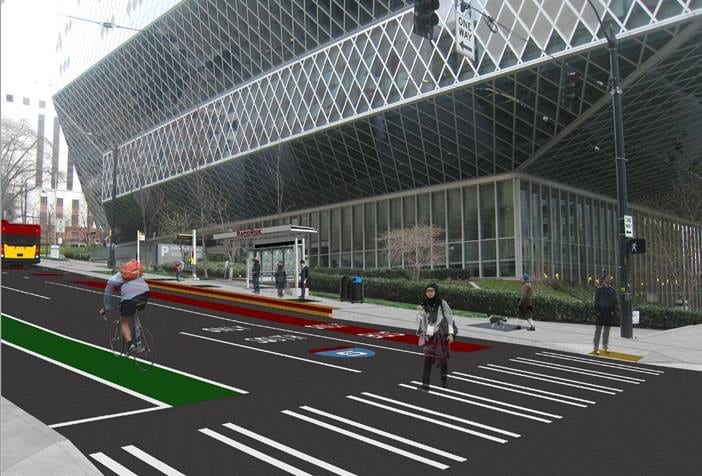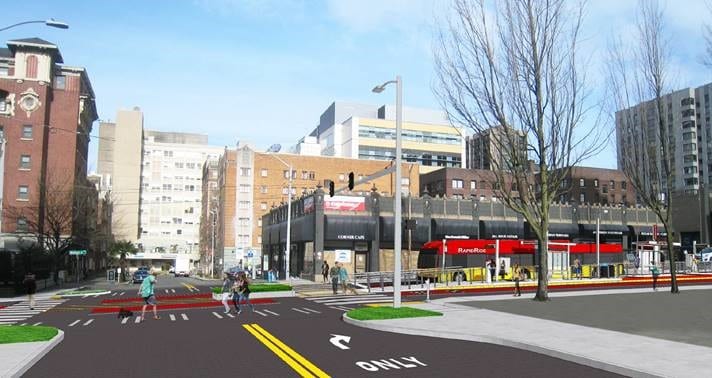
Update (Sept 25, 2020) – We have completed the final two milestones necessary for the Small Starts Grant Agreement to receive this federal grant (finalizing a third-party agreement with Sound Transit and receiving Seattle City Council approval).
We’ve passed an important milestone with the Federal Transit Authority (FTA) moving the Madison Bus Rapid Transit (Madison BRT) project, also known as the RapidRide G Line, forward in the Small Starts Grant review process.
A draft report released by the FTA this month determined SDOT has the resources, skills, capacity, and sound plan necessary to move forward with the Madison Bus Rapid Transit Project. Read more about this important project on our website.
The Madison BRT—RapidRide G Line will create a fast, frequent, and safe east-to-west public transportation line between 1st Ave in downtown’s Central Business District and Martin Luther King Jr Way.
This is the culmination of much hard work by many at SDOT, the FTA, and across the City to move a project of critical importance to our transit network forward and move many steps closer to qualifying for the City’s first Small Starts Grant funding, which will cover about 45 percent of total costs toward the transit project.

This report, formally known as a “Readiness to Execute Small Starts Grant Agreement (SSGA) Review”, is prepared by a Project Management Oversight Contractor (PMOC) on behalf of the FTA, and renders the professional opinion regarding SDOT’s readiness to execute the grant agreement. Clearing the way for the final grant agreement, which is necessary for construction, the report concludes that, “the Sponsor has the organizational capacity and qualified personnel to plan, develop, manage, and complete the MBRT [Madison BRT] project and has demonstrated the ability to recognize and mitigate risks.”
This is significant not only for this project, but for all Seattleites who aspire to building a 21st century infrastructure system capable of equitably and reliably moving more people, while reducing our carbon footprint and congestion on our roads.

To build the city of the future and meet the infrastructure demands of the fastest growing large city of the previous decade, Seattle cannot do it alone. We need strong federal partnership and funding. While SDOT has built many significant infrastructure projects of similar scope and risk to the Madison Street BRT project, this would be the first project supported by FTA funds of this kind. Future smart growth is bolstered by today’s forward progress.
“I am thrilled that the critical Madison Bus Rapid Transit project is moving past this critical milestone. While Seattle builds the best transit and transportation infrastructure in the country, support from our federal partners has become even more critical,” said Mayor Jenny Durkan. “As we deal with the effects of COVID-19, it is more important than ever to invest in a transportation system that gets our frontline workers, historically underserved communities and communities of color where they need to go quickly and reliably.”
The route serves densely developed neighborhoods in downtown Seattle, First Hill, Capitol Hill, the Central Area, and Madison Valley. It connects to dozens of Sound Transit and King County Metro bus routes, the First Hill Streetcar, and ferry service at the Colman Dock Ferry Terminal.
Madison BRT—RapidRide G Line is a partnership between the City of Seattle and King County Metro. King County Metro will operate service on Madison Street as RapidRide G Line.
“This step represents important progress as we work together to build our region’s future,” said King County Metro Interim General Manager Terry White. “We look forward to continuing our partnership with Seattle to provide improved transit service. The new RapidRide G Line will deliver fast, frequent, reliable, and safe public transportation between First Avenue in downtown Seattle and Martin Luther King Jr Way.”

While the Small Starts Grant will play a central role in funding this critical project, it would not be possible without the additional funding provided by the voter-approved Levy to Move Seattle.
The RapidRide G Line, just like the RapidRide H Line which recently broke ground on Delridge Way SW, is one of the many ways that the Levy is investing in a more connected Seattle through transit improvements throughout Seattle.
A vision put in motion as far back as 2012, critical to building the project is the funding plan. SDOT has, and will continue to work closely with the FTA on securing a Small Starts Grant Agreement. As part of their approval process, the FTA hires independent consultants to review project scope, schedule, and risk. For the Madison BRT project, the FTA hired the PMOC in 2019 to align on a successful Project Management Plan (PMP).

As part of an ongoing dialogue, SDOT and the PMOC have worked to collaboratively revise and refine what is now seen as a strong PMP by all parties.
Responding to the latest round of formal feedback SDOT received from the PMOC in late February 2020, SDOT submitted an updated plan in late April 2020. Now, the independent outside experts have submitted their final Project Readiness and Risk Review, finding that SDOT:
“[H]as the organizational capacity and qualified personnel to plan, develop, manage, and complete a major capital project, and has demonstrated the ability to recognize and mitigate risks. The Sponsor has addressed all the negative capacity and capability findings in the PMOC’s previous report,” and is prepared to “successfully deliver the MBRT [Madison BRT] within its budget and schedule and in compliance with federal regulations.”

Sam Zimbabwe, SDOT Director, is enthusiastic about the department’s capacity to continue delivering transit projects for our community. He explained:
“We believe transportation choices are critical to accessing opportunities, and SDOT has played a central role in delivering these transformational changes for Seattleites. Despite challenging economic times, we’ve started construction on our Delridge Way SW RapidRide H Line project earlier this summer, and now we’ve reached an important milestone toward delivering the Madison Bus Rapid Transit project, all aimed at getting people to where they work and live, and increasing access to the important services they need. We appreciate the rigorous review to show our readiness to deliver this massive infrastructure investment and the many job opportunities it will provide as we work toward community and economic recovery.”
SDOT was asked to resolve a few final items, which were completed in September, and we expect to receive a final grant agreement from the FTA as early as December.
- Third-Party Agreements – In September, the Sound Transit Board approved an agreement to provide $35.8M in regional funds identified in the Sound Transit 3 package for the Madison BRT project.
- Funding level – The PMOC requested SDOT increase the amount of cost contingency by an additional $6 million for a revised budget of $133.4 million. (This is in addition to the $6.3 million increase to the November 2019 projected budget at the request of the PMOC.) The change is to cover risks with market conditions and construction, as well as escalation due to the schedule adjustment. Seattle City Council approved this budget change on September 24, 2020.
- Schedule adjustment – SDOT completed a detailed analysis of the construction schedule in response to an earlier recommendation from the PMOC and concluded that a longer construction period is needed. The PMOC subsequently recommended additional schedule contingency, and the PMP now shows a 30 to 36-month construction process with service starting in September 2024. The additional time adds contingency and aligns with one of the two times a year King County Metro initiates new service.
With the funding milestones completed, we expect the FTA to begin the process of developing the grant agreement. Once the agreement is complete, it will go through a review, first by the Office of the Secretary of Transportation followed by Congress and the Department of Labor before execution.
“There are thousands of individuals who arrive for medical care every day at Swedish and hospitals in our neighborhood and hundreds of caregivers who travel to care for those patients every day,” Sherry Williams, Community Affairs Director with Swedish Hospital. “The Madison Bus Rapid Transit will help make it easier for patients and providers to access vital health care facilities in First Hill.”
Once the SSGA is awarded, SDOT will be able to bid the project for construction and advance this critical investment that will reduce transit travel time, significantly increase reliability, reduce vehicular traffic and pollution in the downtown core, and set in motion the many critical job opportunities and investments it represents.
“I’m very excited that SDOT, in partnership with King County Metro, is able to move forward toward bringing bus rapid transit to Madison St, one of the most traveled and in-demand transit corridors in the city,” said Alex Wakeman Rouse, member of the Seattle Transit Advisory Board and Move Seattle Levy Oversight Committee. “The City of Seattle’s Levy to Move Seattle Oversight Committee and the Transit Advisory Board have encouraged SDOT to continue pursuing federal dollars so that, together with other leveraged monies and voter-approved Move Seattle levy funds, the project can be brought to fruition, and more Seattle communities will have access to fast and reliable transit.”